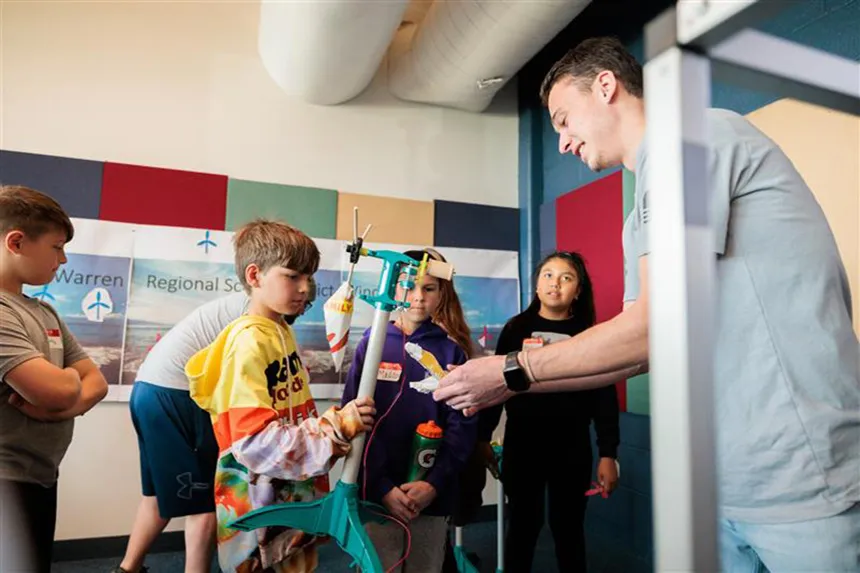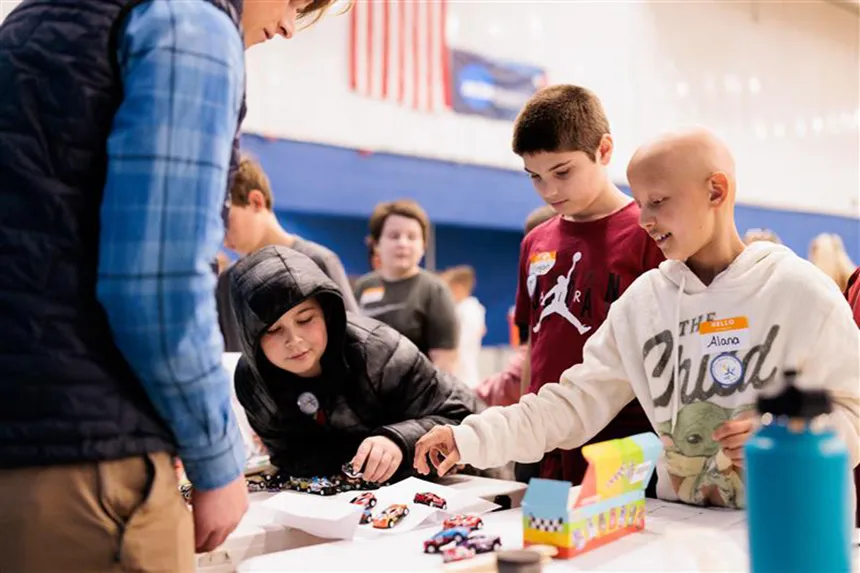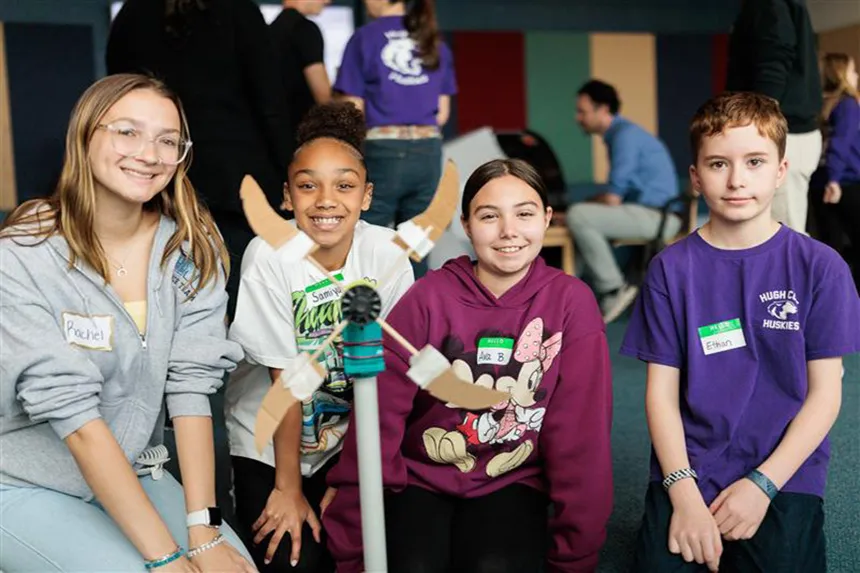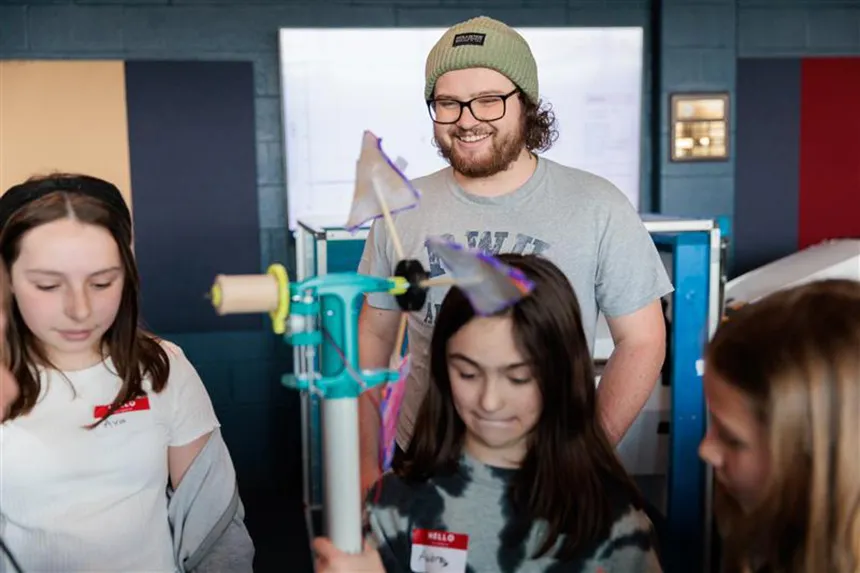RWU Students Teach Fourth Graders About Wind Energy and the Engineering Design Process
Engineering and Education majors team up for KidWind, instructing fourth graders on engineering and how to design and build their own model-scale wind turbines
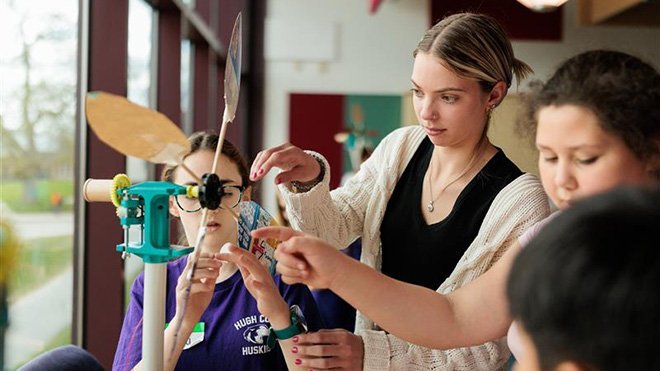
BRISTOL, R.I. – Fourth graders packed the room inside the Roger Williams University Campus Recreation Center, watching with eager anticipation as the next wind turbine is lined up in the “wind test tunnel” and connected to a multimeter by RWU Engineering students. The young students go still as the turbine blades begin spinning, and then erupt in cheers as the electrical output climbs the charts on the screen above the testing module. The higher the electrical output from one of the fourth graders’ turbines, the more energy produced from the students’ enthusiasm for their design.
KidWind, a partnership between RWU and the Bristol-Warren Regional School District (BWRSD), brought 215 fourth graders and their teachers to the university on April 19 to celebrate engineering and STEM education. During the spring semester, RWU Engineering and Education majors team up to teach wind energy and engineering design to the entire BWRSD fourth-grade class, across four elementary schools.
The initiative started in 2019, when RWU Assistant Professor of Engineering Maija Benitz and Associate Professor of Science Education Li-Ling Yang saw an opportunity for RWU to help fill a gap in the local school district and give Roger students a unique experiential learning opportunity. New federal education standards had begun requiring engineering to be taught in elementary schools, and RWU’s Education and Engineering programs could offer its expertise in STEM education and engineering with a focus on the blue economy.
“KidWind is a great example of how school districts and higher education can partner to advance STEM learning in ways that are beneficial to all parties,” said Diane Sanna, Assistant Superintendent of BWRSD. “This creates a strong foundation for future learning and is a great segue to the engineering and STEM classes we offer at the middle school and the accredited Engineering Career and Technical program at Mt. Hope High School.”
Five years after KidWind at RWU began, Benitz said, offshore wind development is exploding in Rhode Island.
“KidWind is creating more opportunities for our students to find pathways into the offshore wind industry – not just for Engineering students, but now we have Education majors who are really good at communicating about wind energy,” Benitz said. It’s also had an impact on nearly 1,000 young students, she added: “Our fourth graders who participated in 2019 are now eighth graders. As the project continues, eventually we’ll have high school graduates who completed KidWind. I hope that becomes a path for more Rhode Island residents to get involved in the offshore wind industry. It’s a really exciting place to be.”
The KidWind blueprint
This year, 36 Education students in Yang’s Teaching Inquiry Science in the Elementary School class and 26 Engineering students in Benitz’s Sustainable Energy Systems course collaborated to create and teach new lesson plans on engineering design in the fourth-grade classrooms. They led the young students through how to design and build their own model-scale wind turbines. Each group of fourth graders was empowered to choose their own optimal blade design and constructed their turbines from recycled materials (a BWRSD sustainability initiative).
“My students love KidWind days,” said Jen Cotoia, a Science and STEM teacher at Colt Andrews Elementary School in Bristol who’s participated in every KidWind. “The program really pushes the students to explore new things and think differently. It's a huge process, but it’s really neat to see how they come together and explore all of these different ideas.”
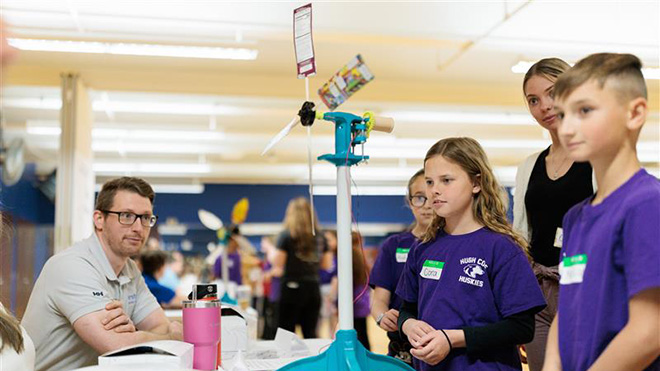
The hands-on learning experience culminated with testing out their designs at RWU, with the fourth graders bringing 52 wind turbines to put to the test. At the wind tunnel station, Chloe Guimelli, a fourth grader at Rockwell Elementary School in Bristol, shared that her favorite part of the engineering design process was changing the angles of the blades to see how it affected energy output. “KidWind showed me that while engineering may be difficult, it’s mostly fun,” she said.
After testing its electricity-generating capacity, the fourth graders presented their designs to a panel of experts, with engineers from Orsted, SouthCoast Wind, and TPI Composites. They also got a few more lessons in the engineering design process led by RWU students, including working together on a structural design for a paper bridge that could support Hot Wheels cars and building handheld catapults from popsicle sticks and rubber bands, giggling and applauding as they launched pom-poms through the air.
Building skills from experience
By working together across disciplines, Benitz said the RWU Engineering and Education students learned from each other while also developing real-world skills that will set them apart in their careers.
Benitz’s students gain confidence in how to effectively communicate about engineering design, a skill that’s necessary to be a successful practicing engineer.
“Because the fourth graders don’t know the technical words, translating everything in a way for them to understand was a little challenging at first,” said Edvin Caniz-Garcia, a junior Mechanical Engineering major from West New York, N.J. “This project showed me that there’s room for improvement in how to explain things. I learned how to better communicate. If you’re able to teach a little kid, you’re able to talk to someone who’s an expert in the field.”
Similarly, Yang said she’s seen how her Education students gain confidence in teaching STEM subjects after working with their Engineering peers on KidWind.
“I have never been strong in science. As an aspiring teacher, it’s difficult when you have doubts,” said Molly Madden, a junior Elementary Education major and Psychology minor, from Burlington, Conn. “Working with the engineers, they made everything so incredibly hands-on while also explaining it thoroughly to us before they explained it to the kids. Being able to understand the engineering design process and apply it now gives me more confidence for when I have a classroom of my own and am teaching these concepts by myself.”
